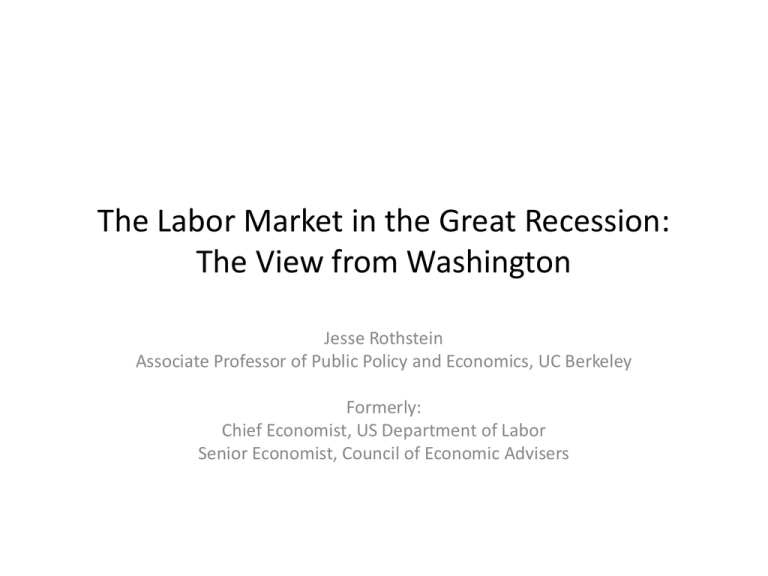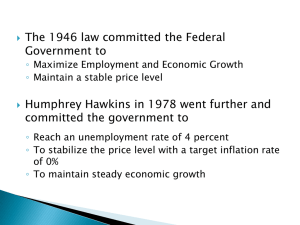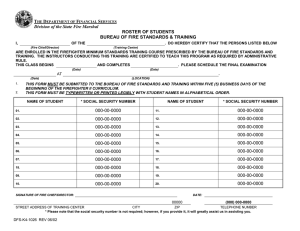The Labor Market in the Great Recession: The View from Washington
advertisement

The Labor Market in the Great Recession: The View from Washington Jesse Rothstein Associate Professor of Public Policy and Economics, UC Berkeley Formerly: Chief Economist, US Department of Labor Senior Economist, Council of Economic Advisers Outline • Where we’ve been & where we are • Aggregate demand or structural problems? • Policy responses This is an extraordinarily deep recession Real GDP (beginning of recession = 100) 103 102 101 100 99 98 97 1974-5 96 1980 1981-3 95 1990-1 94 2001-2 93 2007-2009 92 1 2 3 4 5 6 Quarters Source: Bureau of Economic Analysis 7 8 9 10 11 Employment Change Since the Recession Began 101 100 99 1974-6 1980 percent 98 1981-3 1990-3 97 2001-4 2007- 96 95 94 93 1 3 5 7 9 11 13 15 17 19 21 23 25 months Source: Bureau of Labor Statistics 27 29 31 33 35 37 39 41 43 45 Monthly Change in Total Nonfarm Employment (thousands) 600 400 200 0 -200 -400 -600 -800 -1000 2007 - Nov 2008 - May Source: Bureau of Labor Statistics 2008 - Nov 2009 - May Year 2009 - Nov 2010 - May Source: Office of Management and Budget (FY 2011 budget) Forecast for U.S. Civilian Unemployment Rate 11 Percent 9 7 5 3 1999 2001 2003 2005 2007 2009 2011 2013 2015 Source: Bureau of Labor Statistics and Office of Management and Budget (FY 2011 Mid-Session Review) 2017 2019 Part 2: Is there a structural problem? • Too little job creation? • Skill or geographic mismatches? • Too little job search? Okun’s Law Over the Great Recession Source: Daly, Mary and Bart Hobijn, “Okun’s Law and the Unemployment Surprise of 2009” Mismatch between workers and jobs Diffusion Index for 12-month industry employment growth 100% 75% 50% 25% 0% 1991 - Jan 1994 - Oct Source: Bureau of Labor Statistics. 1998 - Jul 2002 - Apr 2006 - Jan 2009 - Oct Mismatch between workers and jobs Diffusion Index for 12-month metropolitan employment growth 100% 75% 50% 25% 0% 1980 1985 1990 1995 Source: Department of Labor, Office of the Chief Economist. 2000 2005 2010 Unemployed 27 weeks or more as a share of all unemployed 50 45 40 35 Percent 30 25 20 15 10 5 0 1980 1985 1990 1995 Year Source: Bureau of Labor Statistics 2000 2005 2010 New Hires and Long-Term Unemployment 4.4 7 6 months 4.2 Hires rate (left axis) Hires rate (JOLTS) 6 4.0 5 3.8 4 3.6 3 3.4 2 3.2 3.0 Jan-00 1 Long-term unemployment (right axis) 0 Jan-02 Jan-04 Jan-06 Jan-08 Jan-10 Long-term unemployment (millions) 8 Policy responses • Three categories: – Aggregate demand stimulus – Structural reforms – Labor supply policies • Specifics – Increase G – Marginal incentives to hire – Training & mobility subsidies Growing and Shrinking Establishments 100 Share of establishments (%) 90 80 Shrinking establishments 70 60 50 Stable establishments 40 30 20 Growing establishments 10 0 1993Q1 1995Q1 1997Q1 1999Q1 2001Q1 2003Q1 2005Q1 2007Q1 2009Q1




